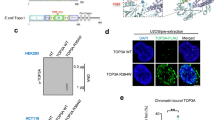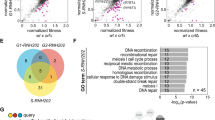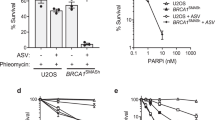Abstract
Ribonucleoside monophosphates (rNMPs) mis-incorporated during DNA replication are removed by RNase H2-dependent excision repair or by topoisomerase I (Top1)-catalyzed cleavage. The cleavage of rNMPs by Top1 produces 3′ ends harboring terminal adducts, such as 2′,3′-cyclic phosphate or Top1 cleavage complex (Top1cc), and leads to frequent mutagenesis and DNA damage checkpoint induction. We surveyed a range of candidate enzymes from Saccharomyces cerevisiae for potential roles in Top1-dependent genomic rNMP removal. Genetic and biochemical analyses reveal that Apn2 resolves phosphotyrosine–DNA conjugates, terminal 2′,3′-cyclic phosphates, and their hydrolyzed products. APN2 also suppresses 2-base pair (bp) slippage mutagenesis in RNH201-deficient cells. Our results define additional activities of Apn2 in resolving a wide range of 3′ end blocks and identify a role for Apn2 in maintaining genome integrity during rNMP repair.
This is a preview of subscription content, access via your institution
Access options
Access Nature and 54 other Nature Portfolio journals
Get Nature+, our best-value online-access subscription
$29.99 / 30 days
cancel any time
Subscribe to this journal
Receive 12 print issues and online access
$189.00 per year
only $15.75 per issue
Buy this article
- Purchase on Springer Link
- Instant access to full article PDF
Prices may be subject to local taxes which are calculated during checkout






Similar content being viewed by others
Data availability
The data that support the findings in this work are available from the corresponding authors upon request.
References
Jinks-Robertson, S. & Klein, H. L. Ribonucleotides in DNA: hidden in plain sight. Nat. Struct. Mol. Biol. 22, 176–178 (2015).
Williams, J. S. & Kunkel, T. A. Ribonucleotides in DNA: origins, repair and consequences. DNA Repair (Amst.) 19, 27–37 (2014).
Clark, A. B., Lujan, S. A., Kissling, G. E. & Kunkel, T. A. Mismatch repair-independent tandem repeat sequence instability resulting from ribonucleotide incorporation by DNA polymerase epsilon. DNA Repair (Amst.) 10, 476–482 (2011).
Kim, N. et al. Mutagenic processing of ribonucleotides in DNA by yeast topoisomerase I. Science 332, 1561–1564 (2011).
Rigby, R. E., Leitch, A. & Jackson, A. P. Nucleic acid-mediated inflammatory diseases. Bioessays 30, 833–842 (2008).
Schellenberg, M. J., Tumbale, P. P. & Williams, R. S. Molecular underpinnings of Aprataxin RNA/DNA deadenylase function and dysfunction in neurological disease. Prog. Biophys. Mol. Biol. 117, 157–165 (2015).
Nick McElhinny, S. A. et al. Genome instability due to ribonucleotide incorporation into DNA. Nat. Chem. Biol. 6, 774–781 (2010).
Sparks, J. L. & Burgers, P. M. Error-free and mutagenic processing of topoisomerase 1-provoked damage at genomic ribonucleotides. EMBO J. 34, 1259–1269 (2015).
Huang, S. Y., Ghosh, S. & Pommier, Y. Topoisomerase I alone is sufficient to produce short DNA deletions and can also reverse nicks at ribonucleotide sites. J. Biol. Chem. 290, 14068–14076 (2015).
Sekiguchi, J. & Shuman, S. Site-specific ribonuclease activity of eukaryotic DNA topoisomerase I. Mol. Cell 1, 89–97 (1997).
Cho, J. E., Kim, N., Li, Y. C. & Jinks-Robertson, S. Two distinct mechanisms of Topoisomerase 1-dependent mutagenesis in yeast. DNA Repair (Amst.) 12, 205–211 (2013).
Shuman, S. Polynucleotide ligase activity of eukaryotic topoisomerase I. Mol. Cell 1, 741–748 (1998).
Potenski, C. J., Niu, H., Sung, P. & Klein, H. L. Avoidance of ribonucleotide-induced mutations by RNase H2 and Srs2-Exo1 mechanisms. Nature 511, 251–254 (2014).
Niu, H., Potenski, C. J., Epshtein, A., Sung, P. & Klein, H. L. Roles of DNA helicases and Exo1 in the avoidance of mutations induced by Top1-mediated cleavage at ribonucleotides in DNA. Cell Cycle 15, 331–336 (2016).
Fiorani, P. & Bjornsti, M. A. Mechanisms of DNA topoisomerase I-induced cell killing in the yeast Saccharomyces cerevisiae. Ann. NY Acad. Sci. 922, 65–75 (2000).
Williams, J. S. et al. Topoisomerase 1-mediated removal of ribonucleotides from nascent leading-strand DNA. Mol. Cell 49, 1010–1015 (2013).
Guzder, S. N. et al. Requirement of yeast Rad1-Rad10 nuclease for the removal of 3’-blocked termini from DNA strand breaks induced by reactive oxygen species. Genes Dev. 18, 2283–2291 (2004).
Guillet, M. & Boiteux, S. Endogenous DNA abasic sites cause cell death in the absence of Apn1, Apn2 and Rad1/Rad10 in Saccharomyces cerevisiae. EMBO J. 21, 2833–2841 (2002).
Vance, J. R. & Wilson, T. E. Yeast Tdp1 and Rad1-Rad10 function as redundant pathways for repairing Top1 replicative damage. Proc. Natl Acad. Sci. USA 99, 13669–13674 (2002).
Liu, C., Pouliot, J. J. & Nash, H. A. Repair of topoisomerase I covalent complexes in the absence of the tyrosyl-DNA phosphodiesterase Tdp1. Proc. Natl Acad. Sci. USA 99, 14970–14975 (2002).
Deng, C., Brown, J. A., You, D. & Brown, J. M. Multiple endonucleases function to repair covalent topoisomerase I complexes in Saccharomyces cerevisiae. Genetics 170, 591–600 (2005).
Hamilton, N. K. & Maizels, N. MRE11 function in response to topoisomerase poisons is independent of its function in double-strand break repair in Saccharomyces cerevisiae. PLoS ONE 5, e15387 (2010).
Elford, H. L. Effect of hydroxyurea on ribonucleotide reductase. Biochem. Biophys. Res. Commun. 33, 129–135 (1968).
Nick McElhinny, S. A., Stith, C. M., Burgers, P. M. & Kunkel, T. A. Inefficient proofreading and biased error rates during inaccurate DNA synthesis by a mutant derivative of Saccharomyces cerevisiae DNA polymerase delta. J. Biol. Chem. 282, 2324–2332 (2007).
Megonigal, M. D., Fertala, J. & Bjornsti, M. A. Alterations in the catalytic activity of yeast DNA topoisomerase I result in cell cycle arrest and cell death. J. Biol. Chem. 272, 12801–12808 (1997).
Das, U. & Shuman, S. Mechanism of RNA 2′,3′-cyclic phosphate end healing by T4 polynucleotide kinase-phosphatase. Nucleic Acids Res. 41, 355–365 (2013).
Unk, I. et al. Stimulation of 3′-->5′ exonuclease and 3′-phosphodiesterase activities of yeast Apn2 by proliferating cell nuclear antigen. Mol. Cell. Biol. 22, 6480–6486 (2002).
Christiansen, K., Svejstrup, A. B., Andersen, A. H. & Westergaard, O. Eukaryotic topoisomerase I-mediated cleavage requires bipartite DNA interaction. cleavage of DNA substrates containing strand interruptions implicates a role for topoisomerase I in illegitimate recombination. J. Biol. Chem. 268, 9690–9701 (1993).
Vance, J. R. & Wilson, T. E. Repair of DNA strand breaks by the overlapping functions of lesion-specific and non-lesion-specific DNA 3′ phosphatases. Mol. Cell. Biol. 21, 7191–7198 (2001).
Unk, I., Haracska, L., Prakash, S. & Prakash, L. 3′-phosphodiesterase and 3′-->5′ exonuclease activities of yeast Apn2 protein and requirement of these activities for repair of oxidative DNA damage. Mol. Cell. Biol. 21, 1656–1661 (2001).
Johnson, R. E. et al. Identification of APN2, the Saccharomyces cerevisiae homolog of the major human AP endonuclease HAP1, and its role in the repair of abasic sites. Genes Dev. 12, 3137–3143 (1998).
Unk, I., Haracska, L., Johnson, R. E., Prakash, S. & Prakash, L. Apurinic endonuclease activity of yeast Apn2 protein. J. Biol. Chem. 275, 22427–22434 (2000).
Pouliot, J. J., Yao, K. C., Robertson, C. A. & Nash, H. A. Yeast gene for a Tyr-DNA phosphodiesterase that repairs topoisomerase I complexes. Science 286, 552–555 (1999).
Lin, Y. et al. APE2 promotes DNA damage response pathway from a single-strand break. Nucleic Acids Res. 46, 2479–2494 (2018).
Willis, J., Patel, Y., Lentz, B. L. & Yan, S. APE2 is required for ATR-Chk1 checkpoint activation in response to oxidative stress. Proc. Natl Acad. Sci. USA 110, 10592–10597 (2013).
Ribar, B., Izumi, T. & Mitra, S. The major role of human AP-endonuclease homolog Apn2 in repair of abasic sites in Schizosaccharomyces pombe. Nucleic Acids Res. 32, 115–126 (2004).
Ide, Y. et al. Growth retardation and dyslymphopoiesis accompanied by G2/M arrest in APEX2-null mice. Blood 104, 4097–4103 (2004).
Guikema, J. E. et al. Apurinic/apyrimidinic endonuclease 2 is necessary for normal B cell development and recovery of lymphoid progenitors after chemotherapeutic challenge. J. Immunol. 186, 1943–1950 (2011).
Wallace, B. D. et al. APE2 Zf-GRF facilitates 3′-5′ resection of DNA damage following oxidative stress. Proc. Natl Acad. Sci. USA 114, 304–309 (2017).
Li, F. et al. Role of Saw1 in Rad1/Rad10 complex assembly at recombination intermediates in budding yeast. EMBO J. 32, 461–472 (2013).
Niu, H. et al. Mechanism of the ATP-dependent DNA end-resection machinery from Saccharomyces cerevisiae. Nature 467, 108–111 (2010).
Wilson, M. A. et al. Pif1 helicase and Polδ promote recombination-coupled DNA synthesis via bubble migration. Nature 502, 393–396 (2013).
Van Komen, S., . & Macris, M. & Sehorn, M. G. & Sung, P. Purification and assays of Saccharomyces cerevisiae homologous recombination proteins. Methods Enzymol. 408, 445–463 (2006).
Acknowledgements
We are grateful to P. Sung, N. Hollingsworth, N. Kim, H. Klein, T. Kunkel, and S. Jinks-Robertson for providing plasmids and yeast strains, H. Bedwell for technical support, S. Bell and B. Calvi for critical reading of the manuscript. This work was supported by William and Ella Owens Medical Research Foundation, Nathan Shock Center Pilot grant, and NIH research grant GM71011 (to S.E.L.), ThriveWell Foundation (to E.Y.S.), and GM124765 (to H.N.).
Author information
Authors and Affiliations
Contributions
F.L., Q.W., E.Y.S., S.E.L., and H.N. designed the experiments. F.L., J.-H.S., and J.C. constructed the yeast strains and performed the genetic assays. Q.W. purified all the proteins and conducted the biochemical experiments. X.L. assisted with protein purifications. F.L., Q.W., J.-H.S., J.C., E.Y.S., S.E.L., and H.N. analyzed the data and wrote the paper.
Corresponding authors
Ethics declarations
Competing interests
The authors declare no competing interests.
Additional information
Publisher’s note: Springer Nature remains neutral with regard to jurisdictional claims in published maps and institutional affiliations.
Integrated supplementary information
Supplementary Figure 1 SDS-PAGE analysis of purified protein factors.
a. Purified Polδ complex (~ 0.3 µg of protein in total) was fractionated in 4–20% SDS-PAGE and stained by coomassie blue G-250. b. Purified RFC complex (~ 2 µg of protein in total) and PCNA (~ 0.5 µg) were fractionated in 4–20% SDS-PAGE and stained by coomassie blue G-250. c. Purified Top1 and top1-T722A (~ 0.5 µg each) were fractionated in 4–20% SDS-PAGE and stained by coomassie blue G-250. d. Purified Apn1, Apn2, Tdp1 and Tpp1 from E. coli (~ 1 µg each) were fractionated in 10% SDS-PAGE and stained by coomassie blue G-250. e. Purified Apn2 and apn2-E59A from yeast (~ 0.5 µg each) were fractionated in 4–20% SDS-PAGE and stained by coomassie blue G-250.
Supplementary Figure 2 Analyses of mutants of RAD1, TPP1, TDP1 and APN1 in synthetic lethality with pol2-M644G rnh201∆.
Tetrad analysis results of pol2-M644G rnh201Δ apn1Δ (a), pol2-M644G rnh201Δ rad1Δ (b), pol2-M644G rnh201Δ slx4Δ top1Δ (c), pol2-M644G rnh201Δ tdp1Δ (d), pol2-M644G rnh201Δ tpp1Δ (e), pol2-M644G rnh201Δ pol3-01 (f), pol2-M644G rnh201Δ rad1Δ tdp1Δ (g), pol2-M644G rnh201Δ mre11Δ top1Δ (h), heterozygote diploid cells. Spores of indicated genotypes are marked with solid and dotted circles, squares, triangles, or pentagons.
Supplementary Figure 3 Apn2 does not directly cleave the embedded ribonucleotide but process the terminal cyclic phosphate derived from ribonucleotide cleavage by Top1.
a. Alkaline gel analysis of genomic DNA isolated from yeast strains including wild type, rad1∆, apn2∆, apn2∆ rad1∆, rnh201∆ and rnh201∆ apn2∆ to examine the presence of genomic ribonucleotide. b. Cleavage at the embedded rNMPs by RNase H2 (20 nM), Apn2 (100 nM) and Top1 (100 nM), top1-T722A (100 nM). c. Cleavage at embedded rNMPs by Top1 (20 nM) and top1-T722A (20 nM). d. Cleavage at an abasic site by purified Apn1 (20 nM) or Apn2 (500 nM). e. Processing of 2’, 3’ cyclic phosphate-terminated nicks by Tpp1 (0.01–0.05 nM) and Apn1 (20–100 nM). f. Apn2 (20 and 100 nM) catalyzed processing of phosphate-terminated ribonucleotide end present at a nick, a 3’- end of single-stranded DNA or a recessed 3’- end.
Supplementary Figure 4 Influence of PCNA on DNA end processing by Apn2, Apn1 and Tpp1.
a. Digestion of a recessed 3’-OH end by Apn2 (20 nM) in the absence or presence of PCNA on duplex DNA with either both or single DNA end occluded. b. Digestion of 3’- end harboring a ribonucleotide or a monophosphate attached ribonucleotide by Apn2 (20 nM) in the absence or presence of PCNA. c. Polδ/PCNA-catalyzed primer extension from a 2’, 3’ cyclic phosphate-terminated end in the absence and presence of Apn1 (20 nM) and/or Exo1 (1 nM). d. Polδ/PCNA-catalyzed primer extension from a 2’, 3’ cyclic phosphate-terminated end in the absence and presence of Tpp1 (0.05 nM) and/or Exo1 (1 nM). e. Polδ/PCNA-catalyzed primer extension from a terminal ribonucleotide with a monophosphate attached in the absence and presence of Apn2 (20 nM) or apn2-E59A (20 nM). f. Polδ/PCNA-catalyzed primer extension from a 3’-terminal ribonucleotide in the absence and presence of Apn2 (20 nM) or apn2-E59A (20 nM).
Supplementary Figure 5 A multi-faceted role for Apn2 in the error-free repair of Top1-induced lesions at genomic rNMP sites.
Mis-incorporated ribonucleotides (rU) is cleaved by Top1, which generates 2’, 3’ cyclic phosphate (Δ) and 5’-OH ends. The 2’, 3’ cyclic phosphate termini can be removed by the second Top1 cleavage at 2 bp proximal to the initial Top1 cleavage site. Top1cc generated by the secondary Top1 cleavage may be processed by Tdp1/Tpp1, or Apn2 to promote error-free repair. Otherwise, the Top1-catalyzed ligation across 2 bp gap may cause 2 bp deletion. Alternatively, Apn2 and Srs2-Exo1 process either 2’, 3’ cyclic phosphate termini or 5’-OH ends to initiate error-free gap repair events. Apn2-PCNA also remove 3’ monophosphate ends. Apn2 is a versatile and multi-functional enzyme involved in multiple steps of rNMP repair.
Supplementary information
Supplementary Figures, Supplementary Tables and Supplementary Dataset
Supplementary Figures 1–5, Supplementary Tables 1–3 and Supplementary Dataset Uncropped gels
Rights and permissions
About this article
Cite this article
Li, F., Wang, Q., Seol, JH. et al. Apn2 resolves blocked 3′ ends and suppresses Top1-induced mutagenesis at genomic rNMP sites. Nat Struct Mol Biol 26, 155–163 (2019). https://doi.org/10.1038/s41594-019-0186-1
Received:
Accepted:
Published:
Issue Date:
DOI: https://doi.org/10.1038/s41594-019-0186-1
This article is cited by
-
Signatures of TOP1 transcription-associated mutagenesis in cancer and germline
Nature (2022)
-
Nature of spontaneously arising single base substitutions in normal cells
Genome Instability & Disease (2021)
-
The activity of yeast Apn2 AP endonuclease at uracil-derived AP sites is dependent on the major carbon source
Current Genetics (2021)
-
Genomic alterations and abnormal expression of APE2 in multiple cancers
Scientific Reports (2020)
-
RNases H1 and H2: guardians of the stability of the nuclear genome when supply of dNTPs is limiting for DNA synthesis
Current Genetics (2020)



